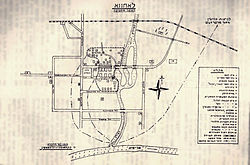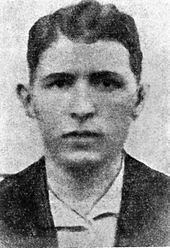Łachwa Ghetto
| Łachwa Ghetto | |
|---|---|
Nazi ghetto | |
Lakhva (Łachwa) location east of Brześć Ghetto and Sobibor extermination camp during World War II
 | |
| Coordinates | 52°13′N 27°6′E / 52.217°N 27.100°E |
| Known for | The Holocaust in Poland |
Łachwa (or Lakhva) Ghetto was a
Background
The first Jews settled in Łachwa,
After the formation of
Ghetto history

On 22 June 1941, Germany invaded the Soviet Union in Operation Barbarossa. Two weeks later on 8 July 1941, the German Wehrmacht overran the town. A Judenrat was established by the Germans, headed by a former Zionist leader, Dov-Berl Lopatin.[4][2] Rabbi Hayyim Zalman Osherowitz was arrested by the police. His release was secured later, only after the payment of a large ransom.[5]

On 1 April 1942, the town's Jewish residents were forcibly moved into a new ghetto consisting of two streets and 45 houses, and surrounded by a barbed wire fence.[6][7] The ghetto housed roughly 2,350 people, which amounted to approximately 1 square metre (11 sq ft) per person.[5]
Uprising and massacre
The news of massacres of the Jews committed throughout the region by German
By August 1942, the Jews in Łachwa knew that the nearby ghettos in Łuniniec (
On 3 September 1942, the Germans informed Dov Lopatin that the ghetto was to be liquidated, and ordered the ghetto inhabitants to gather for "resettlement". To secure the cooperation of the ghetto's leaders, the Germans promised that the members of Judenrat, the ghetto doctor and 30 laborers (whom Lopatin could choose personally) would be spared. Lopatin refused the offer, reportedly responding: "Either we all live, or we all die."[5][6][7]
When the Germans entered the ghetto, Lopatin set fire to the Judenrat headquarters, which was the signal to commence the uprising.
Aftermath

The
References
- ISBN 978-1-61069-879-5.
- ^ Encyclopedia Judaica, 2nd ed., Volume 12, pp. 425–426 (Macmillan Reference USA, 2007)
- ^ a b "Łachwa". History of the Jewish community (in Polish). Warsaw: Virtual Shtetl, POLIN Museum of the History of Polish Jews. 2012. Archived from the original on 2 April 2012 – via Internet Archive.
- ^ https://www.partisans.co.il/Site/site.card.aspx?id=4018 [דב – ברל לופטין]
- ^ a b c d e Pallavicini, Stephen and Patt, Avinoam. "Lachwa", An Encyclopedic History of Camps, Ghettos, and Other Detention Sites in Nazi Germany and Nazi-Dominated Territories, 1933–1945: United States Holocaust Memorial Museum
- ^ ISBN 0-8052-3593-0.
- ^ a b c d e Lachva, Multimedia Learning Centre: The Simon Wiesenthal Center (last accessed 30 September 2006, no archive). Timeline of the Holocaust.
- ^ This Month in Holocaust History: September 3, 1942.
- ^ Yad Vashem, The Holocaust Martyrs' and Heroes' Remembrance Authority; accessed 27 April 2014.
- ^ Sylwester Fertacz (2005). "Carving of the Poland's new map" [Krojenie mapy Polski: Bolesna granica]. Magazyn Społeczno-Kulturalny Śląsk. Archived from the original on 25 April 2009. Retrieved 3 September 2017 – via the Internet Archive.
- ISBN 978-0-306-81650-5.
External links
Pre-war Polish topographic maps showing Łachwa


